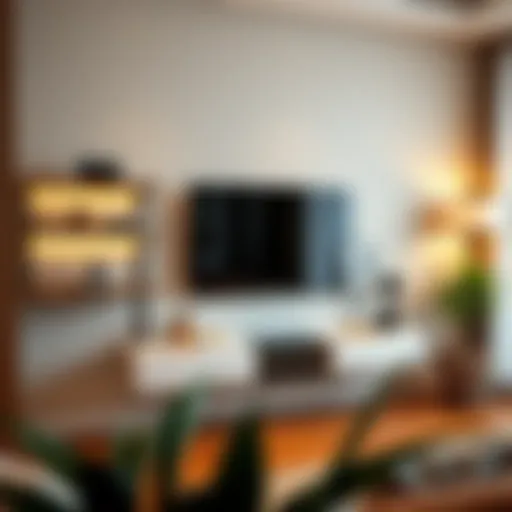Crafting a Chic Home Office Desk: Essential Tips

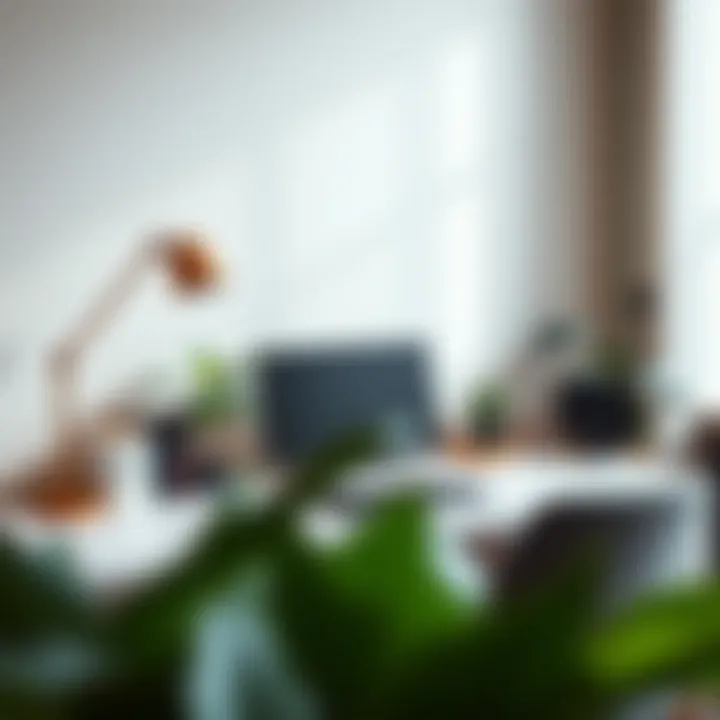
Intro
Creating a comfortable and inviting home office environment goes beyond just functionality; it’s about establishing a personal aesthetic that reflects who you are. Amid the challenges of remote work, homeowners are seeking the perfect blend of style and practicality. This guide aims to walk you through every crucial aspect of designing a stylish home desk that checks all the boxes. We're diving into current design trends, material innovations, and many helpful tips to lock in a workspace that is both appealing to the eye and efficient for productivity.
When designing your home desk, consider it as a canvas—your canvas. How you choose to paint it can define not only your workspace but also influence your mood and efficiency throughout the day. Let’s embark on this journey to transform your dreary desk into a delightful workspace.
Design Trends
Contemporary Styles
In today’s world, contemporary desk designs blend seamlessly with minimalism and functionality. Think clean lines, neutral colors, and smart organization tools. Keeping things uncluttered creates an inviting atmosphere. A sleek desk with integrated storage can provide the perfect foundation. consider a floating desk that doesn’t eat into space while making a stylish statement.
Some prominent contemporary styles include:
- Scandinavian Minimalism: Simple, functional, yet warm through the use of natural wood finishes.
- Industrial Chic: Raw materials like metal shelves paired with wooden desks, embracing ruggedness yet maintaining elegance.
- Mid-Century Modern: Characterized by geometric lines and bold colors, it adds a retro feel whilst offering functionality.
Vintage Inspirations
Beyond modern elements, there’s a certain charm in vintage-inspired designs. Vintage desks often tell a story through their wear and craftsmanship. Whether it’s a reclaimed wood desk or an antique-writing table, these pieces add character and warmth to your office.
Integrating vintage pieces doesn’t mean you have to sacrifice function. Pairing a vintage desk with contemporary office accessories creates a unique juxtaposition. Elements to consider:
- Adding a retro desk lamp that feels like it’s straight from another era.
- Using a vintage typewriter as decoration or, if you dare, to type out your thoughts.
- Incorporating family heirlooms or old maps as wall decorations to evoke nostalgia.
“A room without books is like a body without a soul.” – Marcus Tullius Cicero
Material Innovations
Sustainable Materials
In an age where sustainability is paramount, opting for eco-friendly materials is not just trending; it’s a necessity. Bamboo and reclaimed wood are excellent alternatives to traditional materials. Not only do they minimize waste, but they often come with stunning aesthetics that rival their non-eco counterparts.
Some sustainable options include:
- Bamboo furniture: Fast-growing and highly durable, it offers a modern look.
- Recycled Metal: Great for frames and accents, it’s both sturdy and stylish.
- Cork surfaces: Unique, sustainable, and offers sound dampening.
Smart Furniture Technology
With the rise of home automation, integrating smart technology into your workspace can take convenience to another level. Desks now come equipped with smart features like integrated wireless charging, built-in power outlets, and adjustable heights from sitting to standing with the push of a button.
Let’s explore some forward-thinking functionalities:
- Ergonomic desks and chairs: These support healthy posture and reduce strain.
- Smart organization tools: Items like cable management systems or app-controlled desk features that adapt to your needs.
- Voice-activated assistants: Helping you manage tasks while keeping your workspace tidy.
As you navigate through this guide, remember to keep a vision of your ideal workspace in mind. Balancing these design trends and material options will help you create a home desk setup that feels just right for you while also fostering focus and productivity.
Understanding the Importance of a Stylish Home Desk
Creating a stylish home desk isn’t just about aesthetics; it hinges on crafting an environment that melds functionality with personal flair. The significance of this lies in how a thoughtfully designed workspace can fundamentally influence your daily tasks and overall quality of life.
Your Workspace and Its Impact on Productivity
A cluttered or uninspiring workspace can serve as a double whammy, detracting from your focus and slowing down your work process. Think of your home desk as your cocoon while you hatch your ideas. When you sit down at a desk that feels organized and visually appealing, your mind is more likely to enter a productive groove.
Research suggests that a well-designed workspace can improve concentration and efficiency. When the surroundings resonate with your personal style, they can spark creativity and motivate you to tackle that to-do list head-on.
Additionally, incorporating elements such as adequate lighting, specific color schemes, and the right materials facilitates a sense of comfort. Whether it’s the warmth of a wooden desk or the sleekness of metal accents, your choice of materials sends subtle messages about your personality and work ethic. The right setup can keep weariness at bay, letting your brain focus on what matters most.
Aesthetic Appeal and Personal Expression
A home office should be more than just a workspace; it's a reflection of who you are. It stands as a canvas for personal expression—each item, from desk accessories to wall art, embodies individual tastes and values. An unconventionally colored chair or quirky artwork might speak to your sense of humor, while a minimalist design could showcase your love for simplicity.
When you embellish your workspace with personal touches, it transcends functionality. It becomes a backdrop for your life’s story—a blend of aspirations, achievements, and everyday moments. This aesthetic appeal elevates the ambiance, encouraging positive vibes and a creative atmosphere.
Moreover, creating a stylish desk encourages you to respect your work—viewing it as something valuable rather than a tedious chore. Ensuring that the space feels invigorating means you will be more inclined to spend time there, ultimately enhancing your productivity.
"The way your workspace looks reflects how you value your work. Make it count."
Thus, embarking on the journey to style your home desk is not merely a task of arranging items harmoniously; it’s about defining your identity and enriching your workspace with purpose.
Key Elements of a Stylish Home Desk
A stylish home desk does not just happen by chance; it’s the result of careful consideration of various elements that come together to create a harmonious workspace. The invitations to creativity and productivity flow freely when the right components are in play. So, it’s important to grasp what these key elements are and how they work in unison. They not only enhance the visual appeal of the workspace but also optimize functionality, ultimately making your desk a true reflection of you.
Desk Styles: A Spectrum of Options
Choosing the right style for your desk is like picking the right outfit for an important meeting—first impressions matter. Different styles come with their own characteristics and contribute to the atmosphere of your workspace in distinct ways.

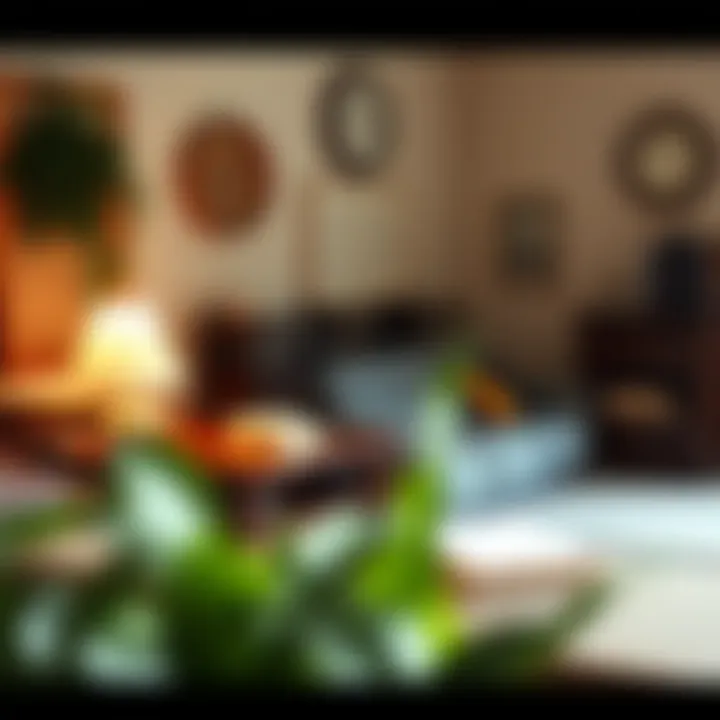
Minimalist Desks
Minimalist desks prioritize simplicity and function over unnecessary embellishments. The hallmark of a minimalist design is sleek lines and a clutter-free environment, which can help clear your mind for focused work. This approach is very beneficial as it promotes a calm, distraction-free space, resonating particularly well with those who appreciate a tidy aesthetic.
Unique features often include built-in storage solutions that hide away mess without sacrificing style. However, a drawback for some may be the lack of personal touch or warmth that more decorative styles may offer.
Industrial Designs
Industrial designs throw practicality and rugged appeal into the mix. Characterized by raw materials, exposed structures, and a somewhat unfinished look, this style has made waves in contemporary design. It’s especially favorable among those who want their workspace to reflect an urban vibe.
The unique feature here often lies in mixed materials, like metal and wood, creating contrast and interest. On the flip side, this style may not resonate with everyone, as its rough edges can feel too sterile or impersonal for some.
Traditional Styles
Traditional styles invite timeless elegance into the home office setting. Sturdy wood construction, detailed carvings, and a rich finish are typical characteristics that convey sophistication. Many see this as a beneficial style due to its classic appearance, which can lend an element of authority to home-based workspaces.
What’s unique about traditional desks is their intricate designs, often becoming a conversation piece. However, these might not suit those looking for a modern or minimalist approach, as they can sometimes feel heavy or overwhelming in a smaller space.
Modern Creations
Modern creations offer a fresh take on desk design. Known for their innovative forms and uses of new materials, they embody a certain forward-thinking appeal. A major characteristic is the use of bright colors and unconventional shapes, which can inject personality into the workspace.
Often the unique feature is the ergonomic design of these desks, supporting comfort and health while you work. However, some may find that these striking designs can overshadow functionality or practicality, depending on the individual’s needs.
Choosing the Right Materials
The materials utilized for your desk can make a world of difference in terms of appearance and function. From wood to metal to glass, each has its own character and advantages, as well as drawbacks.
Wood Varieties
Wood is often seen as a go-to for desks. With many varieties available like oak, walnut, and birch, each offers a unique finish and grain pattern. This material is favored because it brings warmth and a natural aesthetic to the workspace.
What makes wood a popular choice is its durability, standing the test of time when well cared for. However, wood may require a bit more maintenance to keep it looking pristine compared to synthetic materials, especially if you’re prone to spills.
Metal Elements
Metal elements, often found in industrial or modern desks, provide a sturdy base and a sleek look. Frequently used in legs or as a primary material, metal can convey a sense of strength and stability. It’s particularly beneficial for those looking for a cutting-edge style mixed with rotational flexibility, as metal often allows for adjustable features.
The downside is that metal surfaces can sometimes get cold and uninviting, potentially clashing with a more cozy or rustic aesthetic.
Glass Surfaces
Glass surfaces bring a touch of modern elegance with their reflective properties. They create a sense of openness in any room, making them a good choice for smaller spaces. This sleek option can visually enlarge the environment, which is a significant advantage for many home office enthusiasts.
On the downside, glass can be fragile and may require special cleaning products to maintain its clarity without scratches or fingerprints.
Sustainable Options
Sustainable materials have gained traction in recent years, appealing to the eco-conscious consumer. Various sustainable woods and recycled materials are now available, allowing you to blend responsibility with style.
What sets sustainable options apart is their minimal environmental impact. Choosing these materials often means investing in pieces that tell a story and support better practices. However, the design options may not always align with the aesthetic you’re aiming for, requiring more searching to find the right fit.
Ergonomics: Merging Comfort With Style
Creating a home desk that looks good is important, but the way we use that space is even more critical. Ergonomics plays a colossal role in making sure comfort isn't sacrificed for aesthetics. If your desk is all about style and not set up correctly, it can lead to discomfort, fatigue, and even longer-term health issues. This section delves into the essentials of ergonomic design, how to position your workspace for optimal function, and the best choices for your monitor, chair, and accessories—all while keeping style in mind.
The Importance of Ergonomic Design
Ergonomic design isn’t just a fancy term; it’s about crafting a workspace that respects human anatomy and improves overall work quality. When ergonomics are factored in, you're not only making your setup more comfortable but also significantly increasing your productivity. A well-adjusted workspace can mitigate the risk of repetitive strain injuries and reduce muscle fatigue. Plus, when everything fits well and feels right, your workflow becomes smoother, allowing for better focus and creativity.
Proper ergonomic choices reflect an understanding of how different elements in your workspace contribute to or hinder your comfort and effectiveness. This awareness leads to better decision-making regarding the design and organization of your home office.
Positioning for Optimal Functionality
Ideal Monitor Height
When we talk about monitor height, we're touching on one of the pillars of ergonomic design in a home office. An ideal monitor height means that your screen sits at or slightly below eye level. This arrangement helps reduce strain on your neck and eyes. It's a relatively simple adjustment that can drastically improve comfort over long hours of use. A key characteristic of this positioning is that it allows for a neutral neck position, preventing stiffness and long-term injury.
Advantages:
- Helps maintain a relaxed posture
- Reduces eye strain, especially when paired with blue light blocking settings
- Can boost productivity as comfort expands focus
Disadvantages:
- Some monitors may require stands, adding cost
- Adjusting your desk setup can require time and effort to find what works best
Desk Chair Selection
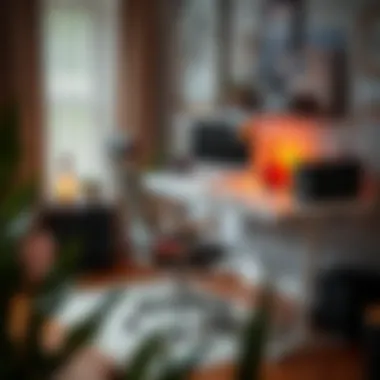

Choosing the right desk chair is like finding a partner who keeps you steady while you work. A chair that properly supports your back and keeps your feet flat on the ground can mean the difference between a productive day and one filled with aches and pains. Look for adjustable features such as height, lumbar support, and seat depth. A chair that promotes good posture allows you to sit comfortably for extended periods, thereby enhancing your work output.
Advantages:
- Encourages proper sitting posture, which leads to less fatigue
- Can be customized to suit individual body types
- Often equipped with features like wheels and rotation, enhancing mobility
Disadvantages:
- Quality ergonomic chairs can be a bit pricy
- Adaptation time may be required as you adjust to a new chair
Keyboard and Mouse Placement
Keyboard and mouse placement is often overlooked but crucial for a comfortable workspace. Your keyboard and mouse should be positioned so that your arms are close to your body and your elbows are bent at about a 90-degree angle. This setup alleviates shoulder and wrist strain, allowing for a more fluid typing experience. By keeping them at the correct height, you're not only preventing discomfort in your wrists but also minimizing the risk of conditions like carpal tunnel syndrome.
Advantages:
- Promotes a relaxed posture across arms and wrists
- Can lead to increased typing speed and accuracy
Disadvantages:
- Alternative setups may look cluttered, which could detract from a minimalist aesthetic
- Might take time to adjust if you're used to an inefficient setup
Incorporating ergonomics into your desk setup isn't simply about comfort—it's a foundational aspect of fostering a productive and stylish home office. With careful attention to monitor height, chair selection, and your keyboard and mouse positions, you can create a workspace that's as much about health as it is about aesthetics.
Creating a Cohesive Home Office Environment
Creating a cohesive home office environment is essential when it comes to elevating your home desk’s functionality and aesthetic appeal. A well-designed workspace fosters a sense of harmony and focus, allowing you to be more productive and comfortable. By taking into account elements such as color schemes, lighting, and accessories, you can turn a mundane desk into a vibrant hub of creativity and efficiency.
Rather than just throwing together random bits and pieces, a cohesive design draws from a central theme or palette, which can make the environment feel more intentional. This approach helps not only the mind to stay organized but also reflects your personality and style. After all, this is a space where you’re not just working but thriving, creating, and thinking.
Color Schemes and Finishes
Neutral Palettes
Neutral palettes serve as a foundation for many stylish home desks. Their essence lies in simplicity and subtlety, making them a versatile choice that pairs well with various decor styles. A beige wall paired with a light gray desk can create a soothing environment conducive to focus. One of the key characteristics of neutral palettes is that they can lend a sense of tranquility to your workspace. This is crucial when you’re dealing with stressful tasks or deadlines, as it helps minimize distractions.
However, while they provide a calm backdrop, too much neutrality without any accent can make a space feel bland. Therefore, it’s essential to introduce small pops of color through plants or decorative items to keep the area lively.
Bold Accents
On the flip side, bold accents can bring life and energy to your workspace. Think of a bright, mustard yellow chair sitting against a muted desk or a vibrant piece of art hanging on the wall. Bold colors act as visual focal points, capable of inspiring creativity and motivation.
A striking piece can jolt your brain into gear, especially when you’re feeling sluggish. However, using too many bold colors can lead to a jarring effect which might detract from focus. Thus, using bold accents strategically is the way to go, ensuring they enhance rather than overwhelm.
Texture Variations
Texture variations add depth and intrigue to your workspace. While color can set the mood, texture can provide tactile interest that keeps the environment dynamic. For instance, mixing a wooden desk with metal elements and a soft fabric chair can create a visually engaging setup. Each of these textures invites interaction and contributes to a layered aesthetic.
However, managing texture can be a bit tricky—too many might create chaos rather than cohesion. Balance needs to be a priority; aim for a couple of textures that complement rather than compete with each other.
Incorporating Lighting into Your Design
Beyond color and material choices, lighting plays a crucial role in creating an inviting home office. Proper lighting not only enhances the look of your setup, but it also protects your eyesight and helps in boosting your mood.
Natural Light Enhancement
Natural light enhancement is about making the best use of sunlight in your workspace. Positioning your desk near a window can significantly improve your overall work experience. The key characteristic of natural light is its ability to uplift your energy and improve concentration. Studies tie exposure to daylight with increased productivity and better mood.
But on the flip side, not all spaces come with ample natural light, making it a challenge for some. Window coverings can mitigate glare; yet, they often diminish this precious resource.
Task Lighting Choices
Task lighting serves a specific purpose in your work area, illuminating your desk and reducing eye strain. Desk lamps, particularly those with adjustable brightness, are vital in creating a focused, dedicated work zone. Significant because they direct light precisely where you need it, task lights can help reduce fatigue during long working hours and promote a healthier work routine.
But care needs to be taken to keep workspace clutter minimal, as too many light sources can lead to visual confusion.
Ambiance Considerations
Finally, how about ambiance considerations? This goes beyond just functional lighting and taps into the mood you wish to create in your office. Warm lighting often makes for a cozier feel, encouraging relaxation, while cooler lights can stimulate focus. The right ambiance has the power to ground you in your work while also letting your creativity roam.
*
In crafting the amalgamation of color, texture, and lighting, you're not merely assembling objects but creating a sanctuary tailored to your personal workflow. An environment that resonates with your style and needs can ultimately lead to greater fulfillment in your work-life balance.
Discover more tips on setting your ideal workspace at Wikipedia or explore discussions on decor at Reddit.
By investing time to harmonize these elements, you bridge the gap between mere functionality and personal expression, allowing your home office to bloom into a place where ideas flourish.

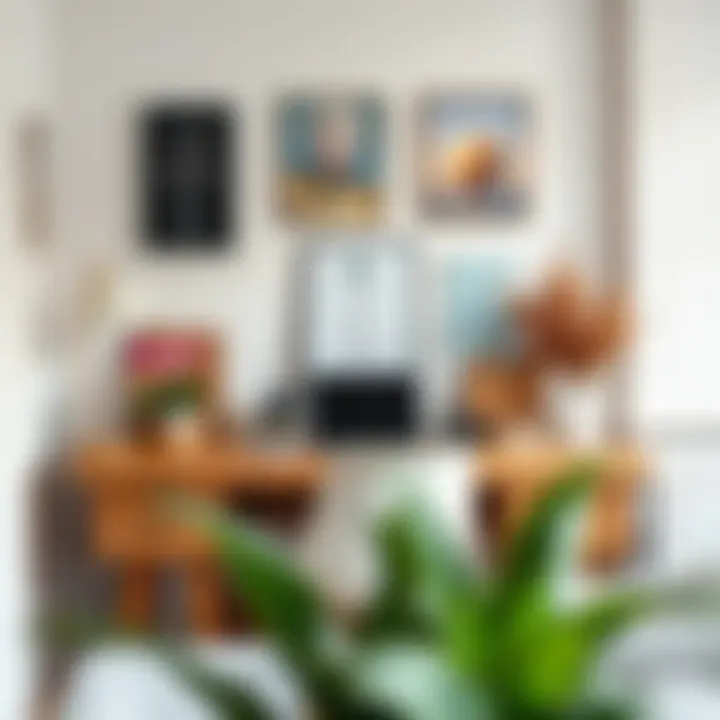
Personal Touches: Adding Character to Your Desk
You know, there's something special about adding personal touches to your home desk. It’s not just about functionality or efficiency; it’s about creating a space that feels like an extension of you. A stylish home desk can amplify your creativity, help you feel more at ease, and, let's face it, make work feel a little less like work.
Personal touches shape the atmosphere and have a way of giving life to an otherwise ordinary workspace. These unique elements invite inspiration and keep you grounded, acting as daily reminders of what fuels your passion. Think of your desk as a blank canvas, where every accessory tells a story or conveys a piece of who you are!
Let’s dive into a few essential ways to add those character-boosting accessories and technology pieces.
Decorative Accessories that Inspire
Artwork and Prints
A desk adorned with carefully chosen artwork and prints can truly transform the mundane into something inspiring. Imagine sitting down for your daily tasks and the first thing your eyes meet is a vibrant piece that sparks joy or a motivational quote that resonates with your personal journey. Framed prints or original art increase visual interest and can set the tone for your entire workspace.
These pieces can range from colorful abstract prints to nature photography, or even your child’s delightful crayon drawings. The key characteristic to remember here is that artwork doesn’t just look good; it evokes emotion and can boost your mood while working. An advantage of incorporating prints is their versatility. You can change them out as your tastes evolve without breaking the bank. On the downside, some artworks may clash with your overall design, so it's wise to consider how they fit into your existing decor.
Organizational Tools
When it comes to keeping a stylish desk, organizational tools are invaluable. These pieces not only promote tidiness but also add an aesthetic appeal that solidifies your workspace style. Think elegant trays, chic pen holders, or unique shelving units designed to keep items within arm's reach yet organized.
A standout feature of these tools is their functionality combined with style. You can find options in various materials—like wood, metal, or even eco-friendly plastics—each contributing a different vibe to your work area. The benefit is clear: a well-organized desk reduces stress and clutter, allowing for clearer focus on your work. However, ensure the organizational items you choose do not overcrowd your space; minimalism can be just as stylish as a richly adorned desk.
Greenery and Plants
Let's not underestimate the power of greenery. Incorporating plants into your home desk setup not just adds visual appeal but also promotes well-being. Studies have shown that integrating greenery into workspaces can increase productivity and improve air quality.
Consider adding a small potted succulent or a string of pearls. These plants are easy to care for and can thrive in indoor conditions. Their organic shapes and vibrant colors have a calming effect, breaking the sterile look of typical office supplies. However, it's important to keep in mind that not everyone has a green thumb. Low-maintenance plants are best if you want the benefits of nature without the added worry of upkeep.
Incorporating Technology Elegantly
Cables Management
In our tech-driven world, messy cables can ruin an otherwise pristine desk setup. Effective cables management is key to keeping things looking sharp. The unsightly tangle of wires can be a real eyesore, detracting from the stylish ambiance you are working to create. It's worth investing in cable organizers, clips, or even sleeves designed to conceal those cables while maintaining accessibility.
A key characteristic of good cables management is that it offers not just aesthetics but functionality; you won’t waste time hunting for that one charging cable in the mess. Plus, a neat setup reduces the likelihood of tripping over cables, promoting safety. Embracing a functional yet stylish approach will generally help you maintain focus, although it might take a little extra effort to set up initially.
Tech-Friendly Accessories
Here’s where practical meets stylish. Tech-friendly accessories like keyboard trays that tuck away or screen separators can enhance your workflow while supporting your design theme. These accessories must blend seamlessly into your desk without drawing too much attention yet remain visually appealing.
Choose accessories made from materials that match your existing decor—a sleek mouse pad in leather could be just the accent your desk needed. However, some tech accessories may not always fit with all styles, so make sure they enhance rather than detract.
Smart Desk Solutions
The modern workspace is evolving, and smart desk solutions are at the forefront. Whether it’s a desk that can adjust to multiple heights or one that incorporates technology to track your sitting or standing habits, these innovative features bring a level of functionality that's hard to overlook.
The notable aspect of smart desks is their ability to adapt to individual needs, which may boost productivity through tailored ergonomics. Improved functionality combined with sleek design defines this category. However, they often come with a higher price tag, which is a consideration if you're working within budget constraints.
To wrap it up, adding personal touches to your desk isn’t just for decoration; it’s about crafting an environment that nurtures your work habits and reflects your individuality. Every piece you choose contributes to a workspace that's not only functional but also deeply personal.
Maintaining Your Stylish Home Desk
Maintaining your stylish home desk doesn't just keep the surface looking sharp; it speaks volumes about how you view your workspace. A cluttered or dirty desk can not only stifle creativity but also hinder productivity. People often overlook the need to care for their workspaces, thinking it’s just about the initial setup. Regular upkeep is like keeping the engine of a car in top shape – it ensures everything runs smoothly and efficiently.
Moreover, there’s something undeniably fulfilling about a well-organized, clean desk. It creates an atmosphere conducive to focus and task completion. Beyond that, it reflects personal pride in one’s environment, demonstrating that you value your space and your work.
Regular Cleaning Practices
Regular cleaning practices are the bedrock of maintaining your home desk. Dust accumulates like a bad habit, and if you let it go unchecked, it can lead to an uninviting workspace. A simple routine can make all the difference:
- Daily Dusting: Wipe down surfaces to remove dust and debris. It only takes a few minutes, and it’s well worth it.
- Organizing Items: Keep like-items together; pens with pens, papers with papers. This way, you can find what you need at a glance.
- Sanitizing Surfaces: Especially post-pandemic, using wipes on your desk can help reduce germs and create a healthier workspace.
Establishing these regular cleaning rituals will keep your desk not just tidy but welcoming.
Updating Your Desk Design Periodically
Updating your desk design periodically helps keep your workspace fresh and relevant to your current needs and tastes. It’s kind of like a haircut – sometimes you need a trim to feel renewed. Regular tweaks can revitalise your environment, making it less predictable and more inspiring.
Seasonal Changes
Seasonal changes can influence how you redesign your desk. As the weather changes, so can your style. For instance, spring often beckons light colors and natural elements, while autumn might sway you towards deeper hues and cozy textures. Why would this be beneficial? Implementing seasonal changes keeps your workspace dynamic and can shift your mood positively. On the flip side, switching themes can involve work; you may need to invest in new items or decorations—worth it if it enhances your creativity.
Trend Adaptations
Trend adaptations allow you to keep pace with evolving aesthetics and functional approaches in design. They encourage a space that feels current and aligned with broader styles. Picking up elements from popular trends not only reflects your eye for style but also keeps your desk in sync with the latest movements. However, it is crucial to balance trendy pieces with timeless elements. Too much focus on fads can lead to a workspace that feels dated quickly. When effectively integrated, trends can revitalize your desk and keep you engaged without overwhelming the entire setup.
Functional Upgrades
Functional upgrades look to improve the efficiency of your workspace while maintaining its style. Think of introducing ergonomic tools like standing desks or adjustable chairs that not only beautify but also promote health and comfort. Such additions are advantageous as they combine aesthetic appeal with functional benefits. However, consider the costs; while some upgrades are worth every penny, not all will align with your budget. Making selective choices here ensures that your desk is both stylish and purposeful, steering clear of unnecessary clutter.
"A workspace is not just about functionality; it’s about embodying a style that resonates with who you are."
Regular maintenance, from cleaning practices to seasonal updates, is key in ensuring your desk environment continues to serve you well. Keeping it stylish requires continual attention and adjustment, but the payoff is a workspace that truly reflects you.







